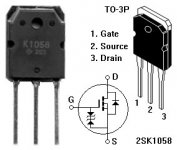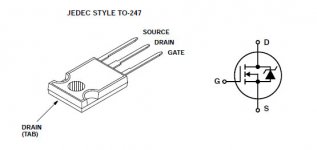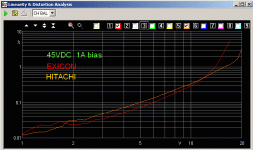Re: What makes a quiet component?
If you are talking about noise in the output transistors, it's not a very important parameter, much more important in the input stage, 70-90% of all noise is generated there.
Noise has lot's to do with process technology.EternaLightWith said:Why are certain transistors and MOSFets, etc. more quiet than others. I guess I'm asking if there is a variable that makes tem better or worse for audio? I'm assuming that the higher the voltage, beta, and bandwidth, the higher the noise.
The reason I ask is that I want to make Rangy's OptiMOS and I wanted to know what the quiestest components I could put in there. I don't think I'll need 200W version with high effeicent speakers so I was planning on lowering the wattage.
Eternalightwithin
If you are talking about noise in the output transistors, it's not a very important parameter, much more important in the input stage, 70-90% of all noise is generated there.
Yes I realize that. I had the input and VAS in mind actually. So are you saying that you really can't tell the noise characteristics, or lack thereof hopefully, unless you listen to it.
I was just curious if there were certain attributes you could look at and guessimate whether a device was low or high noise.
Eternalightwithin
I was just curious if there were certain attributes you could look at and guessimate whether a device was low or high noise.
Eternalightwithin
MOSFET's have allways more noise than other types but as long as you don't have them as input transistors you don't have to worry. Noise is never specified for power MOSFET's, only for RF like dualgate mosfet's.
I don't know if it's possible to estimate the noise just by looking at the transistor and how it's built? Never thought about it really.
I don't know if it's possible to estimate the noise just by looking at the transistor and how it's built? Never thought about it really.
Banned
Joined 2002
are you thinking about building a hitachi lateral amplifier from www.aussieamplifiers.com..
I bought 4 of Sloan's transistors and the exicon transistors (the 200v ones with more current). I plan on doing some listning tests but I have to admit I haven't gotten the amp built. Most of the circuit boards are populated, I need an enclosure.
So I'm not sure if they work well or not yet.
So I'm not sure if they work well or not yet.
Here are Spice models for all the Exicon devices. I got them
from Exicon, so they should be OK.
http://www.diyaudio.com/forums/atta...eplacements-2sk1058-hitachi-exicon-mosfet.zip
Hello,
these models are true to reality?
Here are Spice models for all the Exicon devices. I got them
from Exicon, so they should be OK.
I had a very hard time trying to find these models, I am just making this post to hopefully make the search easier for someone else later. This includes models for the EXC10N20 and EXC10P20. Thanks for sharing.
The IR devices are NOT a drop-in replacement for the Hitachi devices. The lateral devices have very different characteristics from HEXFETs. The zero tempco bias point for the Hitachis is around ~100mA; for the HEXFETs it is Amps (!), so you will have to do a bias regulator, unless you are doing Class A as Mr. Pass does.
mlloyd1
They aren't even pin-to-pin compatible!
Attachments
"Original Post by Christer View Post Here are Spice models for all the Exicon devices. I got them from Exicon, so they should be OK."
I had a very hard time trying to find these models, I am just making this post to hopefully make the search easier for someone else later. This includes models for the EXC10N20 and EXC10P20. Thanks for sharing.
Unfortuately there seems to be a typo in the Exicon model file that has been posted above, in particular one value for the ecf20P20 Kp=0.548 (which is the same value as the ecf10P25)
The ecf20P20 has two-die so it must be about double the single-die version ecf10P20 which is Kp=0.511. Assuming it is a typo, we could simply double the ecf20P20 Kp to fix it. The ecf20P20's Kp then should be more like Kp=1.022.
I haven't checked the Internet to see if anyone else has spotted this or if Exicon have a corrected version. Please let us know if there are any updates on the file posted above 'Model generated on Feb 7 2000'.
My measurements of Exicon 10N20, 10P20 and 20N20, 20P20 give higher values of Kp for the P devices -- being closer to Kp=1.8 at 25 C for twin-die 20P20.
In 2015 I measured at pair of single-die and a pair of dual-die 25 C and 75 C and V & I measured to +/-1%. My models can be found here if you would like to try them Better power MOSFET models in LTSpice
- Status
- This old topic is closed. If you want to reopen this topic, contact a moderator using the "Report Post" button.
- Home
- Amplifiers
- Solid State
- Lateral MOSFET replacements for 2SK1058 (Hitachi)


